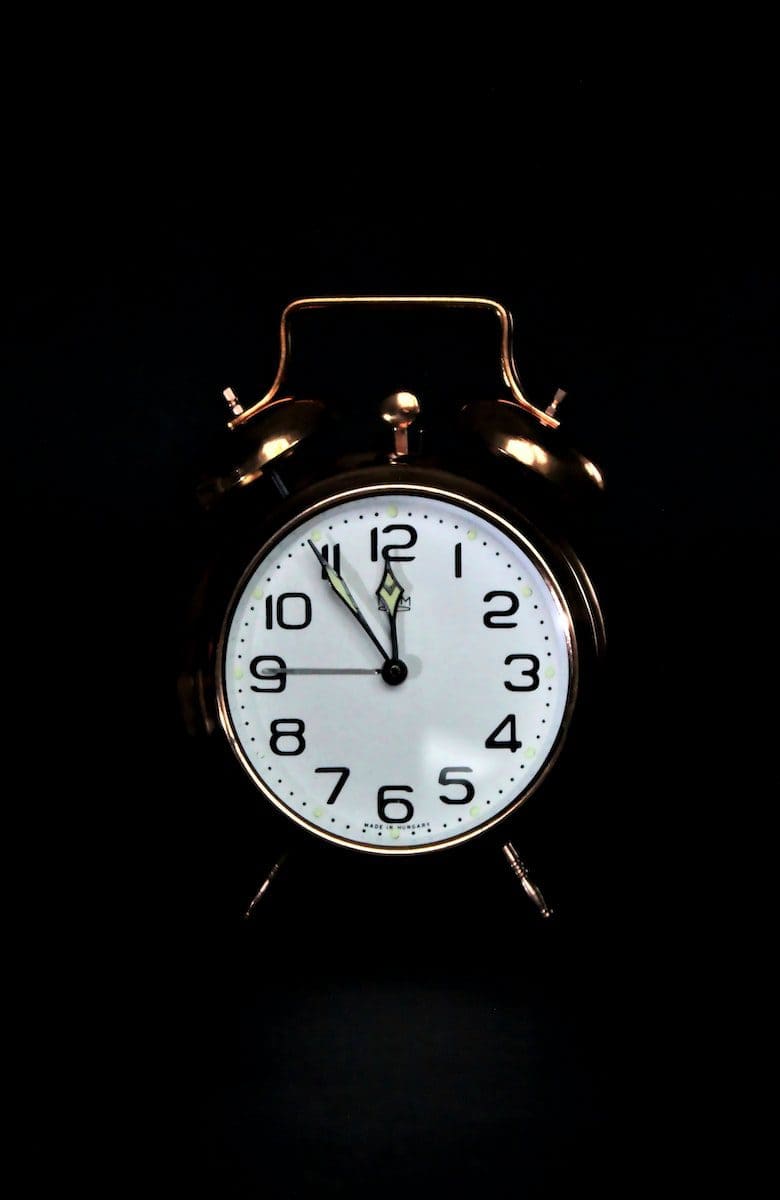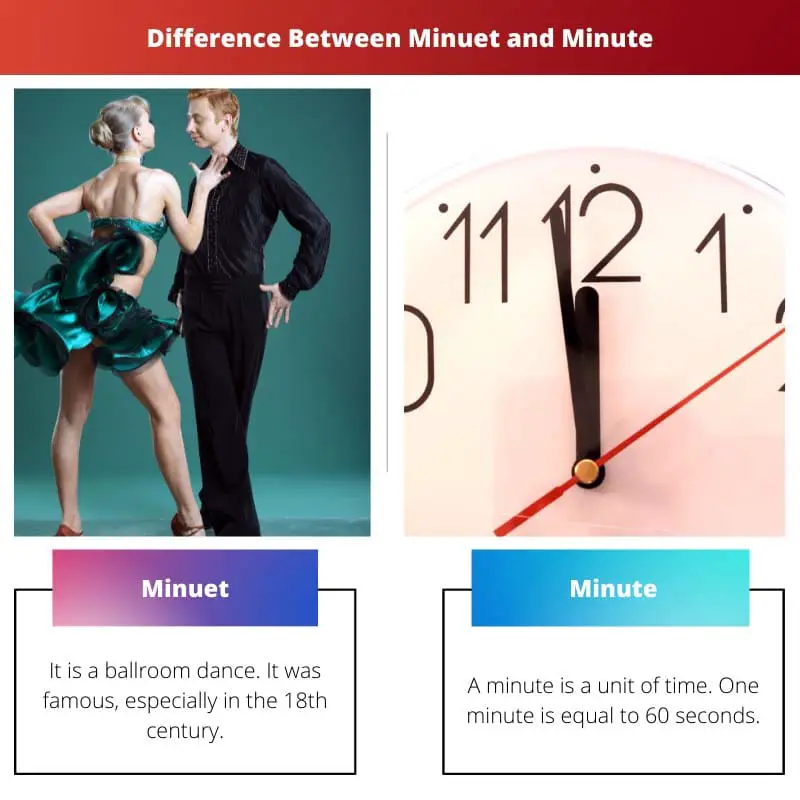Minute is referred to the length of time. Mostly Minuet is considered as a mistake of Minute. One minute is considered 60 seconds. The usage of Minute is done to express the time.
Minutes can refer to the main points discussed in the meeting. Meetings also have minutes that specify points discussed.
Key Takeaways
- Minuet is a type of dance that originated in France during the 17th century, while a Minute is a unit of time equal to 60 seconds.
- Minuet is performed by couples slowly and gracefully, while Minute measures short periods.
- Minuet is a type of art, while Minute is a unit of measurement.
Minuet vs Minute
Minuet is the famous ballroom dance of the 18th century. It is performed by a couple. Steps are taken slowly in this dance. It is a simple and attractive dance. A minute defines time. There are sixty seconds in one minute. It can also be used for the measurement of an angle. The main points discussed in a meeting are also considered meeting minutes.

A minuet is a dance form that originates from France. It is a dance consisting of two people, mostly performed at social functions. It is performed 34 times. The word was taken from minuetto, which is in Italian, and Menuet, which is in French.
Minute is the length of time. It is used as a unit of time. 1 minute is equal to 60 seconds. One minute is 61 seconds in the UTC standard. It refers to a very small amount. It refers to the points discussed in any gathering or confidential meetings.
Comparison Table
| Parameters of Comparison | Minuet | Minute |
|---|---|---|
| Meaning | Dance form | Unit of time |
| Figure of speech | Verb | Noun, adjective |
| Origin | Minuetto | Minutus |
| Pace | Slow to moderate beats | Constant |
| Depicts | Dance and music | Time, small amount and points discussed in any meetings |
| Angle measurement | No | Yes |
What is Minuet?
It is a ballroom dance. It was famous, especially in the 18th century. It is a slow dance between two people. This dance is always performed in doubles and with slow steps. It is performed with a special song which is a part of the suite or symphony.
It was mostly performed in the Baroque era. The steps are not different. The simplicity of the dance makes this dance quite attractive. It is performed by them gracefully. The tune of the song is very slow.
This is commonly known as a couple of dances. The music for Minuet is three-fourth beats and raises to three-eight beats. The slow steps are referred to as pas menus in French.
Many Italian and French composers used to make minutes in six-eight beats, which made a minute a little bit faster, and the song was quicker than the original Minuet.
It has some repeated sections, which have eight bars in a particular section. The Minuet is always played at a constant speed favorable for dancing with small steps. A bar consists of three beats.
It is considered a formal way of dance. It is performed in any official gatherings. These two words meant something small, and the dance had small steps. A very popular group used to perform a dance form using small steps and was known as Branle a minor.

What is Minute?
A minute is a unit of time. One minute is equal to 60 seconds. It depends on the pronunciation of the words, which brings out many different meanings of the word Minute. This word originated from the Latin word Minutes.
Minute is the length of time. It is used as a unit of time. 1 minute is equal to 60 seconds. Minute is used as an adjective when it refers to time. One minute is 61 seconds in the UTC standard.
It refers to a very small amount. It refers to the points discussed in any gathering or confidential meetings. It has a meaning on the angle measurement. The sixtieth of a degree is also known as a Minute.
One by sixty degrees is equal to a minute of arc. It is also used to give a hint of wait. It refers to a short period. Minute is used as a noun when it refers to something small.
The angle measurement is written as 7’, which denotes 7 minutes. The minute is written as 7 min when written in words. It is mostly used in official meetings to record the important points discussed in the meeting, termed as Minutes.

Main Differences Between Minuet and Minute
- A Minuet is a form of dance, but a Minute is a unit of time.
- Minuet is used as a verb, but Minute can be used as a noun and adjective.
- Minuet originated from the Italian word Minuetto but Minute came from the Latin word Minutus.
- Minuet is of slow beats or moderate beats, but Minute is a constant.
- Minuet is a term used for dance and music, but Minute is used to depict time.
- Minuet has no angle measurement, but Minute has an angle measurement.

- https://books.google.com/books?hl=en&lr=&id=7Jau7GfQkq8C&oi=fnd&pg=PP1&dq=Minuet&ots=nFddND7Ayy&sig=g1y5ynTtxiTHbC-dhd9bTehmZXY
- https://pubs.geoscienceworld.org/ssa/bssa/article/87/5/1209/120230

The comparisons drawn between the Minuet dance form and the Minute as a unit of time were enlightening and well-articulated. The insights shared in this article are truly valuable.
I completely agree, Millie. The article adeptly explores the nuances between Minuet and Minute, shedding light on their distinctive characteristics.
The explanations of the dance form Minuet and the unit of time Minute were clear and concise. It’s always great to learn about such historical and linguistic nuances.
I appreciate the attention to detail in this comparison. It’s fascinating to learn about the etymological and practical distinctions between Minuet and Minute.
Absolutely, Nick. The article effectively highlights the differences and origins of these terms.
The detailed examination of both Minuet and Minute, from their historical origins to contemporary relevance, provides a rich understanding of these terms. This was a delightful read.
I echo your sentiments, Wroberts. This article offers a nuanced and informative analysis of Minuet and Minute, making it an enriching reading experience.
I particularly enjoyed learning about the music and cultural significance of the Minuet dance. The parallels drawn with the Minute as a unit of time were very thought-provoking.
I share your sentiments, Ellis. The article does a great job of exploring the historical and practical aspects of Minuet and Minute.
The comparison of Minuet and Minute from both artistic and quantitative perspectives provided a well-rounded understanding of the two terms.
The coverage of the historical context and usage of Minuet and Minute was comprehensive and enlightening. It’s always rewarding to delve into the intricacies of language and culture.
I couldn’t agree more, Jeremy. Exploring the historical and linguistic dimensions of these terms was intellectually stimulating.
This article provides a well-researched and engaging perspective on the distinctions between Minuet and Minute. Thank you for this insightful comparison.
The detailed comparison of Minuet and Minute, along with the historical contexts and different meanings associated with these terms, was truly illuminating. I thoroughly enjoyed reading this article.
I found the analysis of Minuet’s music and its relationship with Minute as a unit of time to be intriguing. It provided a holistic view of these terms.
I share your enthusiasm, Jrogers. The in-depth exploration of the nuances between Minuet and Minute was both educational and engaging.
This article provides an insightful exploration of the differences between Minuet and Minute, delving into their historical, cultural, and linguistic dimensions. Truly fascinating.
I couldn’t agree more, Jacob. The article’s comprehensive approach to comparing Minuet and Minute was intellectually stimulating and enriching.
The in-depth analysis of Minuet and Minute, coupled with the historical insights, made for a captivating and enlightening read. Kudos to the author for this exceptional piece.
The explanation of the Minuet dance form and its historical context was fascinating. I didn’t realize the dance had such a rich history.
Yes, I found the section on the Minuet very enlightening. The comparison with the Minute was also well-explained.
I agree, Hollie. The details about the Minuet’s musical characteristics were especially interesting.
The distinctions made between Minuet and Minute, from their historical roots to practical applications, were compelling. It’s fascinating to learn about the multifaceted nature of these terms.
I concur, Pete. The comprehensive approach to explaining the differences and usages of Minuet and Minute makes for a captivating read.
Thank you for this comprehensive comparison between Minuet and Minute. I appreciate the detailed explanation of the differences between the two.
I completely agree. The historical context provided for these terms is very insightful.
I found the comparison table particularly helpful. It neatly summarizes the distinctions between Minuet and Minute.